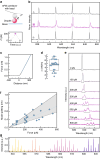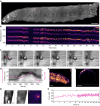Deformable microlaser force sensing
- PMID: 38834554
- PMCID: PMC11150448
- DOI: 10.1038/s41377-024-01471-9
Deformable microlaser force sensing
Abstract
Mechanical forces are key regulators of cellular behavior and function, affecting many fundamental biological processes such as cell migration, embryogenesis, immunological responses, and pathological states. Specialized force sensors and imaging techniques have been developed to quantify these otherwise invisible forces in single cells and in vivo. However, current techniques rely heavily on high-resolution microscopy and do not allow interrogation of optically dense tissue, reducing their application to 2D cell cultures and highly transparent biological tissue. Here, we introduce DEFORM, deformable microlaser force sensing, a spectroscopic technique that detects sub-nanonewton forces with unprecedented spatio-temporal resolution. DEFORM is based on the spectral analysis of laser emission from dye-doped oil microdroplets and uses the force-induced lifting of laser mode degeneracy in these droplets to detect nanometer deformations. Following validation by atomic force microscopy and development of a model that links changes in laser spectrum to applied force, DEFORM is used to measure forces in 3D and at depths of hundreds of microns within tumor spheroids and late-stage Drosophila larva. We furthermore show continuous force sensing with single-cell spatial and millisecond temporal resolution, thus paving the way for non-invasive studies of biomechanical forces in advanced stages of embryogenesis, tissue remodeling, and tumor invasion.
© 2024. The Author(s).
Conflict of interest statement
The authors declare no competing interests.
Figures




Similar articles
-
(De)form and Function: Measuring Cellular Forces with Deformable Materials and Deformable Structures.Adv Healthc Mater. 2020 Apr;9(8):e1901454. doi: 10.1002/adhm.201901454. Epub 2020 Jan 17. Adv Healthc Mater. 2020. PMID: 31951099 Free PMC article. Review.
-
Molecular Tension Probes for Imaging Forces at the Cell Surface.Acc Chem Res. 2017 Dec 19;50(12):2915-2924. doi: 10.1021/acs.accounts.7b00305. Epub 2017 Nov 21. Acc Chem Res. 2017. PMID: 29160067 Free PMC article. Review.
-
A GPU based high-resolution multilevel biomechanical head and neck model for validating deformable image registration.Med Phys. 2015 Jan;42(1):232-43. doi: 10.1118/1.4903504. Med Phys. 2015. PMID: 25563263
-
Protrusion Force Microscopy: A Method to Quantify Forces Developed by Cell Protrusions.J Vis Exp. 2018 Jun 16;(136):57636. doi: 10.3791/57636. J Vis Exp. 2018. PMID: 29985327 Free PMC article.
-
Visualizing the Invisible: Advanced Optical Microscopy as a Tool to Measure Biomechanical Forces.Front Cell Dev Biol. 2021 Sep 6;9:706126. doi: 10.3389/fcell.2021.706126. eCollection 2021. Front Cell Dev Biol. 2021. PMID: 34552926 Free PMC article. Review.
Cited by
-
DNA Sensing with Whispering Gallery Mode Microlasers.Nano Lett. 2025 Mar 19;25(11):4467-4475. doi: 10.1021/acs.nanolett.5c00078. Epub 2025 Mar 4. Nano Lett. 2025. PMID: 40035381 Free PMC article.
-
A material change for ultra-high precision force sensing.Light Sci Appl. 2024 Sep 26;13(1):272. doi: 10.1038/s41377-024-01626-8. Light Sci Appl. 2024. PMID: 39327416 Free PMC article.
References
-
- Gómez-González M, et al. Measuring mechanical stress in living tissues. Nat. Rev. Phys. 2020;2:300–317. doi: 10.1038/s42254-020-0184-6. - DOI
Grants and funding
- EP/P030017/1/RCUK | Engineering and Physical Sciences Research Council (EPSRC)
- AvH Professorship/Alexander von Humboldt-Stiftung (Alexander von Humboldt Foundation)
- (FP/2014-2020/EC | Horizon 2020 Framework Programme (EU Framework Programme for Research and Innovation H2020)
- 640012/EC | EU Framework Programme for Research and Innovation H2020 | H2020 Priority Excellent Science | H2020 European Research Council (H2020 Excellent Science - European Research Council)
- DH160102/Royal Society
LinkOut - more resources
Full Text Sources
Molecular Biology Databases

